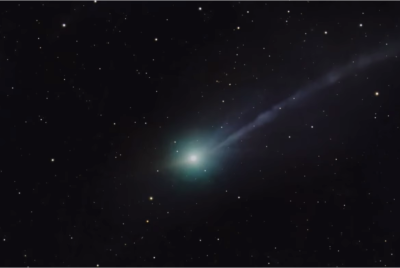3I/ATLAS Alien Signal: NASA Reveals Comet Is Just Water Vapour, Not A Message
Viral claims say interstellar comet 3I/ATLAS is sending alien signals. Scientists confirm: the 'signals' are just natural water chemistry.

This is a tale as old as time, or at least as old as the space age: a strange object flies into our solar system, telescopes focus, and before the scientific community can confirm the data, the whispers begin. The latest object to ignite global speculation is 3I/ATLAS, an interstellar comet now back in the spotlight after a viral clip made the sensational, unverified claim that it is 'sending signals' while approaching Earth.
Officially designated C/2025 N1 (ATLAS), this object was discovered on 1 July 2025 by the NASA-funded Asteroid Terrestrial-impact Last Alert System (ATLAS) survey telescope in Río Hurtado, Chile.
This short social media reel, which stitches together genuine telescope footage with ominous beeps and captions, implies real-time extraterrestrial transmissions are underway. But before you stock up on tinfoil hats, the mainstream scientific consensus is clear: no observatory or radio facility has verified any message.
The excitement surrounding 3I/ATLAS is rooted in real physics—specifically, routine comet physics that just happens to be measurable at radio wavelengths—not alien communication.

The Facts Versus the Fiction: Decoding the 3I/ATLAS Signal Hype
The viral post frames 3I/ATLAS as deliberately broadcasting to Earth, often pairing generic sky footage with a beeping audio track and misleading spectrogram overlays. The resulting rumour, which even recycled an old 'Fibonacci signal' story about radio pulses at the hydrogen line, suggests a decoded, intelligent phrase has been found. The reality is far less dramatic and far more compelling to planetary scientists.
No one has been able to tie the visuals in the clip to a specific observatory log, and there is no released spectrum showing a genuine, modulated transmission. Reporting tracks that lead back to these social media posts show no public data, no official observatory records, and crucially, no confirmation from SETI or any major radio telescope.
3I/ATLAS is only the third confirmed interstellar object ever observed passing through our Solar System, following 1I/'Oumuamua in 2017 and 2I/Borisov in 2019, which adds to the intense public curiosity.
As the scientific community has repeatedly stressed, the object's radio features arise from hydroxyl chemistry, not a communication system. This phenomenon is a completely natural one.
When 3I/ATLAS warms near the Sun, the ice within it sublimates, or turns directly into gas, releasing a vast amount of water vapour. Ultraviolet light from the Sun then splits some of that water into hydroxyl radicals (OH).
These OH molecules imprint narrow, predictable features in radio wavelengths that radio arrays can easily detect. This is a passive spectral fingerprint, a signature of a chemically rich, active comet, not an encoded broadcast or an encrypted message.

Scientific Clarity: 3I/ATLAS is a Comet, Not an Alien Craft
For the majority of astronomers and space agencies, the evidence is overwhelming.
Teams using South Africa's MeerKAT array and NASA's Swift telescope have seen hydroxyl signatures, which is exactly the kind of chemistry fingerprint that forms when sunlight breaks apart water vapour venting from the comet. MeerKAT specifically reported OH absorption consistent with an active, outgassing comet around perihelion. This points to vigorous water loss at surprising distances.
The official word from NASA is unequivocal. Speaking in a Reuters report dated November 19, 2025, NASA's Nicola Fox stated, 'We certainly haven't seen any technosignatures or anything from it that would lead us to believe it was anything other than a comet'.
This position was reinforced by NASA's Associate Administrator Amit Kshatriya, who affirmed, 'This object is a comet... it looks and behaves like a comet. And all evidence points to it being a comet'. That is the consensus across virtually all observatories and agencies.
The mainstream evidence shows 3I/ATLAS as a CO₂-and-water-rich interstellar comet whose radio features arise from natural processes, not communication, on a safe outbound path through the solar system. In short, 3I/Atlas is not secretly talking to us. The real 'signal' is water chemistry in radio and ultraviolet light, and that is the valuable part for science.

The Trajectory of 3I/ATLAS and the Technosignature Debate
While the comet's chemistry is unusual—it is rich in water where others like 'Oumuamua' were dry—its path and behaviour are typical of a natural object. 3I/ATLAS follows a hyperbolic path. Its closest approach to the Sun was around October 30, 2025, near 1.4 AU.
Crucially, its closest point to Earth is about December 19, 2025, near 1.8 AU, roughly 170 million miles. NASA lists the impact risk as zero.
The fact that the comet's official images look like a fuzzy coma with tails rather than a resolved 'craft' is explained by these vast distances. NASA's latest briefing reiterated that 3I/Atlas never gets closer than about 170 million miles from Earth.
All instruments so far suggest it behaves exactly like a natural comet. The comet's estimated diameter is believed to be between 440 metres (1,444 feet) and 5.6 kilometres (3.5 miles).
However, a speculative minority keeps the door open to wider ideas. While NASA's briefing noted that 'no technosignatures' have been seen and that the object's oddities are consistent with jets of gas pushing on the nucleus, some remain unconvinced.
As per an Anadolu Agency report dated November 4, 2025, Harvard's Avi Loeb stated that 'the non-gravitational acceleration might be the technological signature of an internal engine'.
Nevertheless, the data is what counts. 3I/ATLAS is old, fast, interstellar, and unusually active, making the 'signals' revealing its ice, outgassing, and composition exactly the kind of data planetary scientists want.
Don't let viral fiction distract from compelling reality. Comet 3I/ATLAS is not broadcasting alien messages; it is passively revealing the secrets of interstellar water chemistry—a discovery far more valuable to humanity than any hoax.
© Copyright IBTimes 2025. All rights reserved.




















